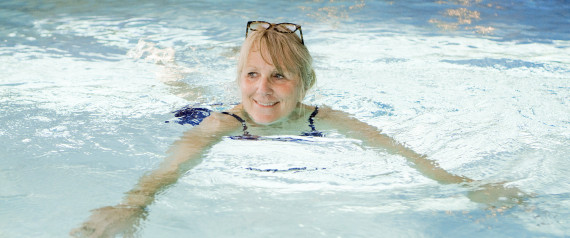If you're like most women, your sneakers are probably collecting more dust bunnies than miles. But if you want to find hormone happiness during perimenopause and menopause, it's due time to dust those babies off!
"All exercise, ranging from housework to running marathons, impacts menopause in a positive way," In fact, exercise can help prevent the muscle and bone loss from which many postmenopausal women suffer, according to the American Council on Exercise. Also, a recent Penn State study found that menopausal women who exercise experience fewer hot flashes in the 24 hours following their workout. While a recent study from the MsFLASH Research Network found some conflicting information -- that aerobic exercise isn't significantly associated with reduced hot flashes -- it did find that exercise does have positive effects on sleep quality, insomnia and depression in both perimenopausal and menopausal women. What's more, exercise may be effective at treating menopausal depression, according to a recent review published in The Cochrane Library," says Dr. Diana Bitner, MD, a North American Menopause Society Certified Menopause Practitioner & Physician and board-certified OB/GYN. "My patients who exercise on a regular basis have fewer menopause symptoms as well as improved body chemistry -- lower cholesterol, better sugar control, less weight gain, and stronger bones. Women who exercise have better sleep, better mood and better quality of life."
According to Dr. Bitner, body fat (which, of course, tends to increase after menopause) spurs hot flashes and night sweats, leads to poor sleep, saps energy, brings down moods and can wreck self-image. Put that all together, and that also means a torpedoed libido. "I talk to my patients about belly fat as a furnace that makes them hot and tired. As belly fat increases, energy decreases and hot flashes, night sweats and sleep disturbances increase. As belly fat increases, so does insulin resistance -- and this can cause cravings for carbohydrates and more menopausal weight gain," she says. "If a patient has a high BMI and body fat percentage, her risk of snoring and sleep apnea increases, adding another reason for poor sleep, low energy, and hot flashes."
Ready to dust off those kicks? Here's how to boost your body for good:
Set the Right Expectations
"Exercise can initially increase hot flashes by increasing body temperature -- especially in women who are overweight. Fortunately, such hot flashes improve as body fat is lost," Dr. Bitner says. So, if you expect yourself to jump right back into your workout where you left off without any changes in performance, you are setting yourself up for (possibly workout-ending) disappointment. Don't worry; you'll get there. Just remember that slow and steady wins the get-fit race. In the meantime, Dr. Bitner recommends staying hydrated and focusing on big, full belly breaths to lessen exercise-induced hot flashes.
Have Fun
The best form of exercise is the one that you will actually do! So find a workout -- or a variety of workouts -- that you love! "Women are more likely to stick to a regimen if they have a workout buddy and if they actually enjoy the activity," Dr. Bitner says. My hubby, David, and I are living proof -- and a match made in workout heaven. Five days a week we ride our bikes together, and two days a week we strength train. Besides being a great spotter, David helps keep me on track -- and in return I cheer him on when he wants to throw in the towel. So who motivates you? Consider exercising with your friends, family members or even your coworkers at lunch. It can be a great way to infuse some fun into your workout routine and make it feel like a little less work. If fitness-loving friends are in short supply, try taking exercise classes where you can meet other health-minded women and get the support you deserve. Who knows, you might just make a lifelong friend while you're at it!
Hit the Big 3
"Exercise has three components: aerobic activity, strength training, and stretching. For the best results, women need a balance of all three," Dr. Bitner says. "Stretching helps avoid injury and improves performance; strength training helps avoid injury, keeps bones strong, and significantly helps weight control; aerobic activity improves fitness and heart health as well as burns calories and helps maintain a healthy weight." She advises that each week you get in one long cardio workout, two shorter interval workouts (think: a brisk walk with quick bursts throughout) and three strength-training workouts.
Play It Safe
"Anyone starting a new or more strenuous exercise regimen should consult their physician in case risk factors for heart disease are significant enough to require a stress test first," Dr. Bitner says. Also, if you have any existing injuries or conditions such as arthritis or osteoporosis, discuss them with your physician before you hit the gym. While they're certainly no excuse to skip the gym (exercise can actually improve many aches and pains!), you need to tailor your workout to fit your body's limitations.
Get Some Help
Enlisting the expertise of my trainer, Daniel Shamburg, MS, CSCS, owner of Shift Fitness in Carlsbad, California, is one of the best investments I've ever made in my health. He comes to my house twice a week, armed with his mantra, "The only machine needed is YOU!" and also lends his get-fit expertise via Google Helpouts and in his studio. If you decide to hire a trainer, make sure he or she has a certification through a body such as the National Strength and Conditioning Association or the American College of Sports Medicine. After all, you want to get fit, not injured!
Put yourself and your exercise routine on the top of your to-do list. Start today! Ditch the exercise excuses and celebrate yourself with a healthy workout!


No comments:
Post a Comment